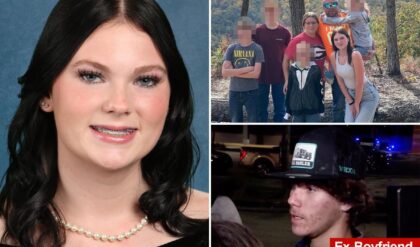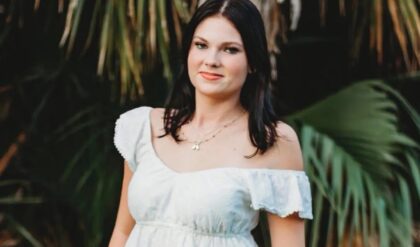The chirpy comedy-drama was a lockdown hit despite a snooty response from critics and Parisians alike. As it returns for season four, we go on set to meet the people making TV’s most divisive show
When Emily in Paris first appeared on television screens during that long pandemic winter of 2020, it was as though a bright bird had flown into a staid dinner party that had gone on for too long. There was excitement; there was glee; there were a great number of feelings about the garishness of the bird. The series, created by Darren Star of Sex and the City fame, follows a young woman from Chicago (Lily Collins) who moves to Paris to work at a PR firm, and offends her French colleagues with her good-natured midwestern cheer and American insistence on working hard.
The show was critically panned and piled on across social media. People pointed to the ludicrousness of the plot (Emily becomes a successful influencer by posting pretty boring photos on Instagram, like “When you dropped your crêpe, #ohcrêpe”); its painfully obvious depiction of Paris, all pains au chocolat and hot chefs and parties in front of the Eiffel Tower and, perhaps most divisive of all, her outfits. (Vogue writer Raven Smith: “The way her ensembles are put together cheese-grates my eyes.”)
I saw all of Emily in Paris’s failings. I understood them. And I loved the show all the same. After months of Covid isolation, looking at nothing much besides my flat, here was a show that resembled a sweet shop – bright pastels, fairytale cobblestoned streets, a city awash with light. Pastries and designer clothes and farmers’ markets were all presented with a beautiful glow. And while millennials on television were typically bruisingly insecure, Emily moved around the world with a breezy, uncomplicated self-belief. Without much effort, she won over her clients, found an Instagram fan in Brigitte Macron and was given a modelling stint that made her the talk of the town.

It was delusional; it was sublime. It was the televisual equivalent of the self-affirmation clips that tell you that the world is a safe, wonderful place, that you are strong and beautiful and can do anything – probably a bit false, but a pleasure to play along with. “The show healed my broken brain,” a friend concluded. Another: “It’s a dumb show. It’s my favourite.”
As work began on season two in 2021, the show began teasing a new British character, and my friends and I began imagining what caricatures of English masculinity would be offered up, ones that would be obvious and corny and therefore delightful: Oxford PhD writing a doctorate about Keats; dreamy aristocrat with an intense attachment to his old nanny; psychologically damaged former public schoolboy whose former public schoolboy father is too busy WhatsApping Westminster friends about backdoor Covid contracts to attend to family life (2021-specific humour). Desperate to see how they’d approach a British storyline, and to generally snoop around, I emailed Netflix about a set visit. Months – and several email chains – later, they confirmed they weren’t hosting visits, and I sat with the rest of the world as we met Alfie, a straight-talking London banker who hates the French and learning French, and loves football and the pub (suggesting perhaps the writers had taken the criticisms of unchecked fantasy to heart, at least for him).
I had given up hope until last winter, when I saw a news article about the show’s plans to finish filming season four in early 2024, before the Olympics. I emailed again. And so on a grey April morning this year, as heavy rain pounded down on the city, I found myself arriving at a large, unassuming warehouse on the outskirts of Paris. Never give up on your dreams.
French cinema is all about three people, bored and depressed. So when someone says, ‘Let’s make people dream’, I love that
We are in a facility in a sprawling, multi-block filming complex, standing in front of the set of Emily’s office. The design is very mid-century millennial; swathes of pastel pink and dusty mauve; gold statement furnishings made for the ’Gram; blue velvet chairs. The atmosphere right now is hushed; the day has yet to begin. We’re a group of four journalists: two from Paris, one from Romania, and me. I get the sense that our reasons for being here today are very different, ranging from “here to do a job” to “live out a long-held fantasy”. I ask one of the Parisian journalists how the show is seen locally; she tells me it’s not as huge. A woman who looks extremely like Lily Collins but is not Lily Collins hovers around the coffee stand (she turns out to be her stand-in). We’ll be in this building for eight hours. We’ll be taken to sets, observe filming, and meet some of the cast and creatives, who will share their feelings about the show’s love-it-or-hate-it reputation.
One of the biggest early criticisms of the show was its stereotyping of French culture. The French, in Emily’s experience, don’t show up to work on time, are all having messy affairs, and the men are hot, horny and incorrigible. Emily asks her boss – a sophisticated woman named Sylvie – to lunch, only to get turned down with: “I’ll have a cigarette.” On set today though, this mixing of cultures feels alive. Emily in Paris feels like an assuredly American production, and we meet a producer and writer from the US, pulled from Darren Star’s earlier productions. But many of its crew members are younger locals, who effortlessly flit between French and English. And while the French we see on screen hate Emily, the people we meet today are fully on board with American fantasy.
“French cinema is all about reality: three people, bored and depressed, drinking alcohol in a room. I love French movies. But it’s true,” says the show’s Toulouse-born costume designer Marylin Fitoussi. “So when someone says to me, ‘I don’t care about reality, let’s make people dream’, I love that.’” Fitoussi is dressed in a vibrant green co-ord, looking as bright as the show with red lipstick and statement jewellery. (“I was inspired by the rain. I was like, let’s wear green, like a frog.”)

‘Do you want to see H&M clothes on screen? I don’t’ … Lily Collins in another understated outfit. Photograph: Stephanie Branchu/Netflix
She speaks with fizzy candour, replying to criticisms about Emily’s luxe designer wardrobe with: “Do you want to see H&M clothes on screen? Do you want to see 25-buck jeans and hoodies that you can afford? Honestly, I don’t. This show is made to be entertainment. I’m a costume designer. I need to fuel your imagination. Showing reality as it is is boring for everybody. Don’t watch a show. Just watch your neighbour and yourself.”
Fitoussi is entirely unapologetic about Emily’s hated outfits: “I’m sure the French will love and hate [this season’s sartorial offerings]. And that’s the point. That is all the point. It’s to make them cry again and again and again.” In season one, there were plans for a scene in which Emily would be taken shopping by Sylvie, to rectify the fact that “you dress like a clown”. But that was judged “too easy”. Emily needed to remain Emily.
We’re ushered to a set of the restaurant owned by the show’s resident hot chef, Emily’s love interest and neighbour Gabriel; it’s a picturesque bistro with a deep red frontage and wooden accents. Sitting with us around a dining table is Star, who tells us that the set was created for ease of filming. (The original restaurant – tucked into a square in the Latin Quarter where much of the show was first shot – has the dubious distinction of now being a beret-wearing influencer hotspot, making it a more difficult place to film the actual show.)
Parisians, it’s not their dream to live here, so maybe they don’t quite understand – it’s not a fantasy for them
“I never understood the hate, quite honestly, why it provoked a reaction,” Star says. “People who live in Paris, it’s not their dream to live here, so maybe they didn’t quite understand how people from all over the world view Paris as this sort of ideal. Those people, who are dealing with their day-to-day lives – it’s not a fantasy for them.”
Star – whose catalogue, as well as Sex and the City, includes Beverly Hills 90210, Melrose Place and Younger, series that assume distinctly female perspectives, with a dash of sugar and wit – says that there’s a “slight wish-fulfilment element” across his work. Nothing is “about depicting the realities of any particular city”, and this show “is a romanticised view of Paris. And that’s unapologetic.”
It is time to meet the star of the show. Lily Collins walks into the room dressed in character, in an outfit that will probably – to borrow Fitoussi’s phrasing – make the people cry. She’s wearing a flouncy white blouse with a statement bow tie that has been paired with a yellow chequered vest and shorts. The best way I can describe it is “avante garde highlander pageboy”, a series of words that probably would ordinarily never be put next to each other, but such is the magic of the show. Collins is switched-on, attentive and charming. “I literally have interacted with people in Paris who have dressed like the character,” she recalls. Americans will tell her: “I’m Emily!”

